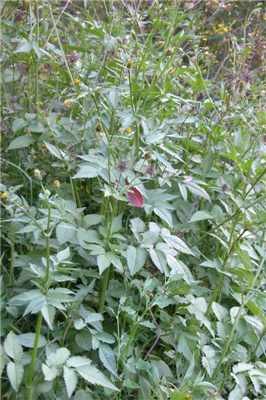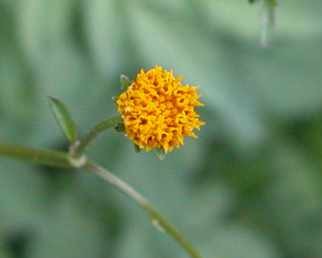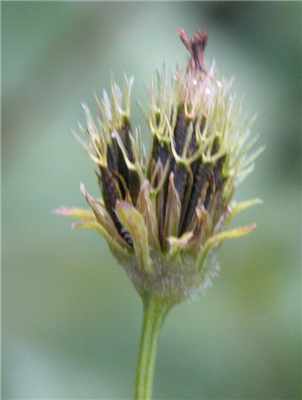Scientific Name
Bidens pilosa L.
Synonyms
Common Names
cobbler's pegs, farmer's friend, stick-tights, pitch-forks, burr marigold
Family
Asteraceae
Origin
Temperate and tropical America
Habit
Erect almost glabrous to densely hairy woody herb that grows to 1m or more high, with angular branches.
Habitat
Any disturbed or waste ground, roadsides and areas that are dry and infertile.
General Description
Stems and Leaves:
The leaves are opposite and are divided pinnately into 3-5 leaflets with toothed margins (edge). The terminal and lateral leaflets are ovate to lanceolate shaped. The petiole (the stalk of a leaf) is very slightly winged.
Flowers and Fruit:
The flowerheads (capitula) are white and yellow and 5-15mm in diameter. They are borne on long slender peduncles (stalks) at the end of the stems. Each flower head has 4 or 5 short, broad, white petals (ray florets) with numerous, yellow disc florets (tubular florets in centre of flowerhead). The outer involucral bracts (a whorl or several whorls of a more or less modified leaves surrounding a flower or an infloresence) have finely hairy margins (edges) and are shorter than the inner bracts. The seeds are slender, linear, curved, black and rigid, they are 4 angled 6-12mm long with 2 or 3 barbed awns (stiff bristle). Flowering occurs throughout the year but primarily summer-autumn.
Distinguishing characteristics
The plants are a characteristic dark green colour and often do not develop flowerheads until at least one metre tall. The black seeds with awns (bristle-like appendages) are very distinctive. Bidens pilosa has outer involucral bracts (a whorl or several whorls of modified leaves surrounding a flower or an infloresence) that are linear or lanceolate and are finely hairy on the margins (edges). The outer involucral bracts are shorter than the inner involucral bracts. Bidens tripartita on the other hand has outer involucral bracts that are spathulate and leaf-like often extending beyond the involucre. Bidens pilosa can be distinguished from Bidens subalternans in that Bidens pilosa has leaflets that are unlobed (rarely partially lobed) and have toothed margins. Bidens subalternans on the other hand has leaflets that are pinnatifid (the leaflets, cut into lobes on both sides of the midrib).
Sources & References
Cunningham GM, Mulham PL, Leigh JH (1981) 'Plants of Western New South Wales.' (NSW Government Printing Office: Australia)
Harden GJ (Ed) (2002) 'Flora of New South Wales.' (University of New South Wales Press Ltd: Sydney, Australia)
Kleinschmidt HE, Johnson RW (1987) 'Weeds of Queensland.' (QLD Department of Primary Industries: Brisbane, Australia)
Pacific island ecosystems at risk (2004) www.hear.org
Prepared by Kylie Pethybridge, 2005
Checked by Carole Campbell, 2005
Updated by Justin KY Chu, July 2005
Checked by Dr Peter Michael, July 2005


